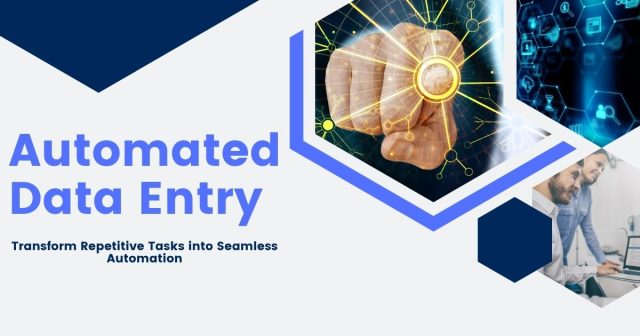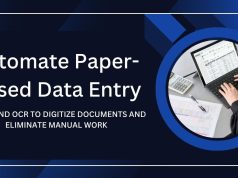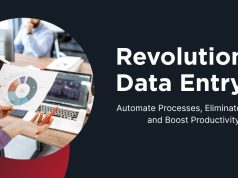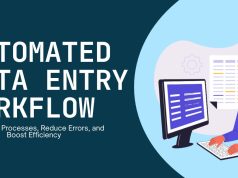Manual data entry has long been the bane of office workers everywhere. Hours spent copying information from one system to another, the inevitable typos, the mind-numbing repetition—it’s a productivity killer that costs businesses both time and money. Automated data entry offers a better way forward.
This technology transforms how organizations handle information by using software to capture, process, and input data without human intervention. From small businesses drowning in invoices to large enterprises managing customer databases, automated data entry solutions can eliminate bottlenecks and free up employees for more strategic work.
If you’re tired of watching your team struggle with manual data tasks or wondering whether automation could solve your data management challenges, this guide will help you understand exactly what automated data entry is, how it works, and why it might be the game-changer your organization needs.
Understanding Automated Data Entry
Automated data entry is the process of using software and technology to capture, extract, and input data into systems without manual typing or copying. Instead of having employees manually transfer information from documents, forms, or other sources into databases or applications, automated systems handle these tasks using various technologies like optical character recognition (OCR), artificial intelligence, and machine learning.
The core principle behind automated data entry is pattern recognition. These systems learn to identify specific types of information—whether it’s invoice numbers, customer names, or financial figures—and extract them from various sources. Once extracted, the data gets formatted and entered into the appropriate fields in your target system.
Common sources for automated data entry include scanned documents, PDFs, emails, web forms, images, and even handwritten notes. The technology has evolved significantly, now capable of processing everything from structured forms to unstructured documents with varying layouts and formats.
How Automated Data Entry Works
The process typically begins with data capture, where the system ingests information from various sources. This could be as simple as monitoring an email inbox for new attachments or as complex as scanning physical documents fed through a high-speed scanner.
Next comes data extraction, where the system identifies and pulls relevant information from the captured sources. OCR technology converts images of text into machine-readable text, while AI algorithms determine which pieces of information correspond to specific data fields.
Data validation follows extraction, ensuring the captured information meets predefined criteria and rules. For example, the system might check that dates fall within acceptable ranges or that email addresses follow proper formatting conventions.
Finally, data integration moves the validated information into your target systems. This could mean updating customer records in your CRM, adding new entries to your accounting software, or populating inventory databases.
Throughout this process, machine learning algorithms continuously improve accuracy by learning from corrections and feedback, making the system more reliable over time.

Types of Automated Data Entry Solutions
Optical Character Recognition (OCR) Systems
OCR technology converts printed or handwritten text from images and documents into digital text. Modern OCR solutions can handle multiple languages, various fonts, and even poor-quality scans. These systems excel at processing invoices, receipts, contracts, and forms.
Intelligent Document Processing (IDP)
IDP combines OCR with AI to understand document context and structure. Unlike basic OCR that simply converts text, IDP can identify document types, extract relevant fields, and understand relationships between different pieces of information.
Robotic Process Automation (RPA)
RPA uses software robots to mimic human interactions with digital systems. These bots can log into applications, navigate through screens, extract data, and input information across multiple systems. RPA works particularly well for repetitive tasks that follow clear rules.
Web Scraping Tools
These solutions automatically extract data from websites, online databases, and web applications. They’re commonly used for price monitoring, lead generation, and market research.
API-Based Integration
Application Programming Interfaces allow different software systems to communicate directly, enabling automatic data transfer without manual intervention. This approach works well when both source and destination systems support API connections.
Key Benefits of Automated Data Entry

Improved Accuracy
Human error is inevitable in manual data entry, with studies showing error rates between 1-5% for even experienced data entry clerks. Automated systems, once properly configured, can achieve accuracy rates above 95%, significantly reducing costly mistakes.
Increased Speed and Efficiency
While a human might process 10-15 invoices per hour, automated systems can handle hundreds or thousands in the same timeframe. This speed improvement doesn’t just save time—it enables faster decision-making and improved cash flow.
Cost Reduction
Although initial implementation requires investment, automated data entry typically pays for itself within months. Organizations save on labor costs, reduce error-related expenses, and free up employees for higher-value activities.
24/7 Processing
Unlike human workers, automated systems can process data around the clock. This continuous operation is particularly valuable for businesses that receive data from multiple time zones or need to maintain real-time information updates.
Scalability
Manual data entry capacity is limited by the number of available staff members. Automated systems can scale up to handle increased volumes without proportional increases in cost or time.
Better Compliance and Audit Trails
Automated systems create detailed logs of all data processing activities, making it easier to maintain compliance with regulations and conduct audits. This documentation can be invaluable for industries with strict regulatory requirements.
Common Use Cases and Applications
Financial Services
Banks and financial institutions use automated data entry to process loan applications, extract information from financial statements, and update customer records. Insurance companies automate claims processing by extracting data from forms, medical records, and damage reports.
Healthcare
Medical practices automate patient registration by extracting information from insurance cards and forms. Hospitals use automated systems to process medical records, lab results, and billing information, reducing administrative burden on healthcare staff.
Retail and E-commerce
Online retailers automate product catalog updates by extracting specifications and descriptions from supplier documents. Inventory management systems automatically update stock levels based on sales data and delivery confirmations.
Human Resources
HR departments automate resume screening by extracting candidate information and qualifications. Employee onboarding processes benefit from automated extraction of information from tax forms, benefits elections, and other documentation.
Accounting and Finance
Accounts payable departments automate invoice processing by extracting vendor information, amounts, and approval codes. Expense management systems automatically categorize and process receipt information submitted by employees.
Challenges and Limitations
Initial Setup Complexity
Implementing automated data entry requires careful planning and configuration. Systems need to be trained on your specific document types and data formats, which can take time and expertise.
Quality of Source Data
Automated systems perform best with clean, well-formatted source data. Poor-quality scans, inconsistent document layouts, or unusual formatting can reduce accuracy and require additional manual intervention.
Handling Exceptions
While automated systems excel at processing standard cases, they often struggle with exceptions and edge cases. Organizations need processes for handling items that fall outside normal parameters.
Integration Challenges
Connecting automated data entry systems with existing software can be complex, especially with older legacy systems that lack modern integration capabilities.
Ongoing Maintenance
Automated systems require regular monitoring, updates, and fine-tuning to maintain optimal performance. Changes in source document formats or business processes may require system adjustments.
Getting Started with Automated Data Entry

Assess Your Current Processes
Begin by documenting your existing data entry workflows. Identify the types of documents you process, the volume of data, and the systems where information needs to be entered. Look for repetitive, rule-based tasks that consume significant time.
Define Success Metrics
Establish clear measurements for success, such as processing time reduction, accuracy improvement, or cost savings. These metrics will help you evaluate different solutions and measure the impact of implementation.
Start Small
Consider beginning with a pilot project focusing on one specific type of document or process. This approach allows you to learn and refine your approach before expanding to other areas.
Choose the Right Technology
Select solutions that align with your specific needs, budget, and technical capabilities. Consider factors like document types, integration requirements, and the level of accuracy needed for your use case.
Plan for Change Management
Prepare your team for the transition to automated processes. Provide training on new workflows and clearly communicate how automation will affect their roles and responsibilities.
The Future of Automated Data Entry
Automated data entry continues to evolve rapidly, driven by advances in artificial intelligence and machine learning. Modern systems are becoming increasingly sophisticated in their ability to understand context, handle unstructured data, and learn from experience.
The technology represents more than just a way to eliminate tedious tasks—it’s a foundation for digital transformation that enables organizations to operate more efficiently and make better use of their human resources. As businesses generate ever-increasing amounts of data, automated entry systems will become essential tools for maintaining competitive advantage.
For organizations still relying on manual data entry, the question isn’t whether to automate, but how quickly they can implement solutions that will free their teams to focus on strategic work that drives real business value.










